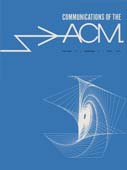May 1970 - Vol. 13 No. 5

Features
A programming system for the on-line analysis of biomedical images
A preliminary description of the software for a computer-display system is given with special emphasis on the man-machine interaction. This system is intended for a wide variety of biomedical applications. As an example, the methods are applied to the karyotyping of chromosomes. The system is separated into four programming tasks: picture transformations, file maintenance, picture structuring, and display management. Picture structuring is considered as the vehicle for man-machine communication. A prototype data format for pictures, called a picture-form, is developed. Structure operators are defined which manipulate picture-forms to produce new picture-forms. Many of the ideas are taken from the symbolic mathematical laboratory at MIT conceived by Marvin Minsky.
Operations on generalized arrays with the genie compiler
Operations on vectors, matrices, and higher dimensional storage arrays are standard features of most compilers today. The elements of such structures are usually restricted to be scalars. For many sophisticated applications this restriction can impose cumbersome data representations. An efficient system has been devised and implemented which allows the elements of multi-dimensional arrays to themselves be multidimensional arrays. This system was developed from a storage structure in which the location, length, and content of each array is described by a codeword which can be interpreted by the system. Codewords may describe arrays containing more codewords, thus providing all needed descriptive information for hyperstructures of any form.
The application of sequential sampling to simulation: an example inventory model
Four different sequential sampling procedures are applied to the analysis of data generated by a computer simulation experiment with a multi-item inventory model. For each procedure the cost of computer time required to achieve given levels of statistical precision is calculated. Also the cost of computer time using comparable fixed sample size methods is calculated. The computer costs of fixed sample size procedures versus sequential sampling procedures are compared.
An algorithm for the construction of bounded-context parsers
An algorithm is described which accepts an arbitrary context-free grammar and constructs a bounded-context parser for it whenever such a parser exists.
In the first part of the paper the definition of a context-free grammar and the working of a bounded-context parser are recalled. The notion of reduction class for a context-free grammar is then introduced and its connection with the structure of a bounded-context parser is indicated. Next, pushdown automata which generate the different reduction classes of a context-free grammar are defined. Finally, the algorithm is described; it essentially carries out an exhaustive study of all possible runs of the pushdown automata generating the reduction classes.
In the second part, the utility of the algorithm is discussed in the light of the experience gained from its use in compiler design. The algorithm is claimed to be particularly useful in the simultaneous design of a language and a compiler for it.
GEDANKEN is an experimental programming language with the following characteristics. (1) Any value which is permitted in some context of the language is permissible in any other meaningful context. In particular, functions and labels are permissible results of functions and values of variables. (2) Assignment and indirect addressing are formalized by introducing values, called references, which in turn possess other values. The assignment operation always affects the relation between some reference and its value. (3) All compound data structures are treated as functions. (4) Type declarations are not permitted.
The functional approach to data structures and the use of references insure that any process which accepts some data structure will accept any logically equivalent structure, regardless of its internal representation. More generally, any data structure may be implicit; i.e. it may be specified by giving an arbitrary algorithm for computing or accessing its components. The existence of label variables permits the construction of co-routines, quasi-parallel processes, and other unorthodox control mechanisms.
A variety of programming examples illustrates the generality of the language. Limitations and possible extensions are discussed briefly.



